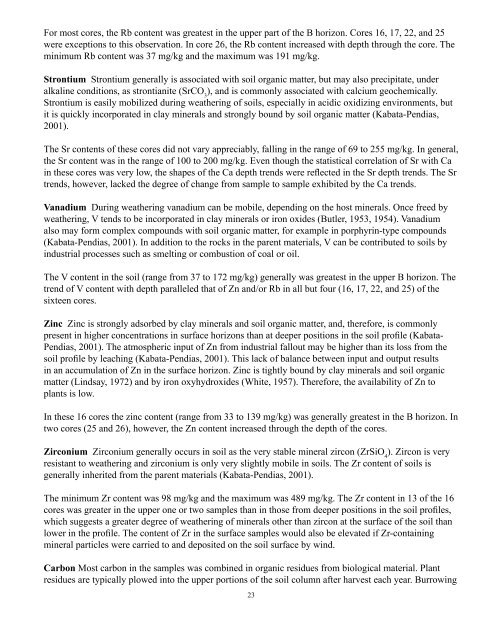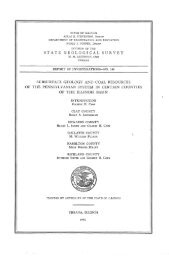Cores 11 through 26 by Gary B. Dr - University of Illinois at Urbana ...
Cores 11 through 26 by Gary B. Dr - University of Illinois at Urbana ...
Cores 11 through 26 by Gary B. Dr - University of Illinois at Urbana ...
Create successful ePaper yourself
Turn your PDF publications into a flip-book with our unique Google optimized e-Paper software.
For most cores, the Rb content was gre<strong>at</strong>est in the upper part <strong>of</strong> the B horizon. <strong>Cores</strong> 16, 17, 22, and 25were exceptions to this observ<strong>at</strong>ion. In core <strong>26</strong>, the Rb content increased with depth <strong>through</strong> the core. Theminimum Rb content was 37 mg/kg and the maximum was 191 mg/kg.Strontium Strontium generally is associ<strong>at</strong>ed with soil organic m<strong>at</strong>ter, but may also precipit<strong>at</strong>e, underalkaline conditions, as strontianite (SrCO 3), and is commonly associ<strong>at</strong>ed with calcium geochemically.Strontium is easily mobilized during we<strong>at</strong>hering <strong>of</strong> soils, especially in acidic oxidizing environments, butit is quickly incorpor<strong>at</strong>ed in clay minerals and strongly bound <strong>by</strong> soil organic m<strong>at</strong>ter (Kab<strong>at</strong>a-Pendias,2001).The Sr contents <strong>of</strong> these cores did not vary appreciably, falling in the range <strong>of</strong> 69 to 255 mg/kg. In general,the Sr content was in the range <strong>of</strong> 100 to 200 mg/kg. Even though the st<strong>at</strong>istical correl<strong>at</strong>ion <strong>of</strong> Sr with Cain these cores was very low, the shapes <strong>of</strong> the Ca depth trends were reflected in the Sr depth trends. The Srtrends, however, lacked the degree <strong>of</strong> change from sample to sample exhibited <strong>by</strong> the Ca trends.Vanadium During we<strong>at</strong>hering vanadium can be mobile, depending on the host minerals. Once freed <strong>by</strong>we<strong>at</strong>hering, V tends to be incorpor<strong>at</strong>ed in clay minerals or iron oxides (Butler, 1953, 1954). Vanadiumalso may form complex compounds with soil organic m<strong>at</strong>ter, for example in porphyrin-type compounds(Kab<strong>at</strong>a-Pendias, 2001). In addition to the rocks in the parent m<strong>at</strong>erials, V can be contributed to soils <strong>by</strong>industrial processes such as smelting or combustion <strong>of</strong> coal or oil.The V content in the soil (range from 37 to 172 mg/kg) generally was gre<strong>at</strong>est in the upper B horizon. Thetrend <strong>of</strong> V content with depth paralleled th<strong>at</strong> <strong>of</strong> Zn and/or Rb in all but four (16, 17, 22, and 25) <strong>of</strong> thesixteen cores.Zinc Zinc is strongly adsorbed <strong>by</strong> clay minerals and soil organic m<strong>at</strong>ter, and, therefore, is commonlypresent in higher concentr<strong>at</strong>ions in surface horizons than <strong>at</strong> deeper positions in the soil pr<strong>of</strong>ile (Kab<strong>at</strong>a-Pendias, 2001). The <strong>at</strong>mospheric input <strong>of</strong> Zn from industrial fallout may be higher than its loss from thesoil pr<strong>of</strong>ile <strong>by</strong> leaching (Kab<strong>at</strong>a-Pendias, 2001). This lack <strong>of</strong> balance between input and output resultsin an accumul<strong>at</strong>ion <strong>of</strong> Zn in the surface horizon. Zinc is tightly bound <strong>by</strong> clay minerals and soil organicm<strong>at</strong>ter (Lindsay, 1972) and <strong>by</strong> iron oxyhydroxides (White, 1957). Therefore, the availability <strong>of</strong> Zn toplants is low.In these 16 cores the zinc content (range from 33 to 139 mg/kg) was generally gre<strong>at</strong>est in the B horizon. Intwo cores (25 and <strong>26</strong>), however, the Zn content increased <strong>through</strong> the depth <strong>of</strong> the cores.Zirconium Zirconium generally occurs in soil as the very stable mineral zircon (ZrSiO 4). Zircon is veryresistant to we<strong>at</strong>hering and zirconium is only very slightly mobile in soils. The Zr content <strong>of</strong> soils isgenerally inherited from the parent m<strong>at</strong>erials (Kab<strong>at</strong>a-Pendias, 2001).The minimum Zr content was 98 mg/kg and the maximum was 489 mg/kg. The Zr content in 13 <strong>of</strong> the 16cores was gre<strong>at</strong>er in the upper one or two samples than in those from deeper positions in the soil pr<strong>of</strong>iles,which suggests a gre<strong>at</strong>er degree <strong>of</strong> we<strong>at</strong>hering <strong>of</strong> minerals other than zircon <strong>at</strong> the surface <strong>of</strong> the soil thanlower in the pr<strong>of</strong>ile. The content <strong>of</strong> Zr in the surface samples would also be elev<strong>at</strong>ed if Zr-containingmineral particles were carried to and deposited on the soil surface <strong>by</strong> wind.Carbon Most carbon in the samples was combined in organic residues from biological m<strong>at</strong>erial. Plantresidues are typically plowed into the upper portions <strong>of</strong> the soil column after harvest each year. Burrowing23
















